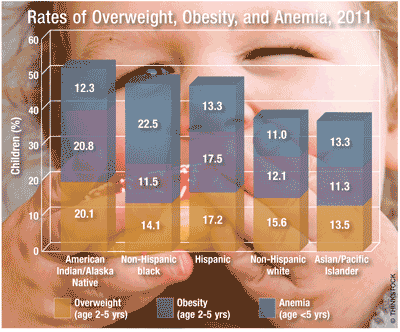US Pharm. 2013;38(5):16.
Studies have shown that public health programs improve health, extend longevity, and reduce health care spending. In 2010, Surgeon General Regina M. Benjamin emphasized the need to focus national attention on wellness and prevention, and toward that end the National Prevention, Health Promotion, and Public Health Council recommended the creation of an environment conducive to healthy choices. Pediatric Nutrition Surveillance System (PNSS) data provide insights into overweight, obesity, and anemia as health indicators in children.

Obesity: Obesity is associated with lifelong health consequences such as diabetes, heart disease, and arthritis. Obese children aged 2 years and older have a high probability of adolescent or adult obesity. Adult obesity affects quality of life and places an additional economic burden on our already-stressed health care dollars. PNSS data on children younger than 5 years reveal that obesity is prevalent in children aged 24 to 59 months. American Indian/Alaska Native children lead in terms of prevalence (20.8%), followed by Hispanic (17.5%), non-Hispanic white (12.1%), non-Hispanic black (11.5%), and Asian/Pacific Islander children (11.3%). Clinical guidelines recommend that BMI be monitored annually in children older than 2 years. Along those lines, Arkansas passed landmark legislation in 2007 to combat childhood and adolescent obesity, whereby from kindergarten through 10th grade students are required to have an annual BMI screening that is reported in confidence to the parents. When the program was initiated, Arkansas was the state with the highest prevalence; since then, the prevalence has dropped, and it ranked 25th in 2011. Utah (with 9% obesity) ranked the highest in the country in 2011.
Anemia: Clinicians and the CDC recognize anemia (hemoglobin concentration <5th percentile for age [<11.0g/dL]) to be associated with developmental delays and behavioral problems. Asymptomatic and multicausal, anemia is detected upon screening. Children younger than 5 years represent one of the highest-risk populations for anemia. In 2011, although anemia (microcytic, normocytic, or macrocytic) was prevalent among children younger than 5 years (14.4%), the rate declined with progression of age. Children younger than 18 months had the highest prevalence (18%), followed by children aged 18 to 35 months (15.4%); the lowest anemia prevalence (10.5%) was in children aged 36 to 59 months. Anemia affected children disproportionately by race: Non-Hispanic black children topped the list (22.5%), followed by Asian/Pacific Islander (13.3%), Hispanic (13.3%), American Indian/Alaska Native (12.3%), and non-Hispanic white children (11%).
Comment: The detection and monitoring of anemia and obesity should be supplemented by other strategies in order to successfully promote wellness among U.S. children.
To comment on this article, contact rdavidson@uspharmacist.com.





